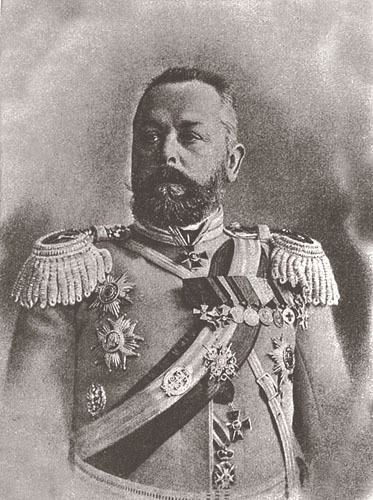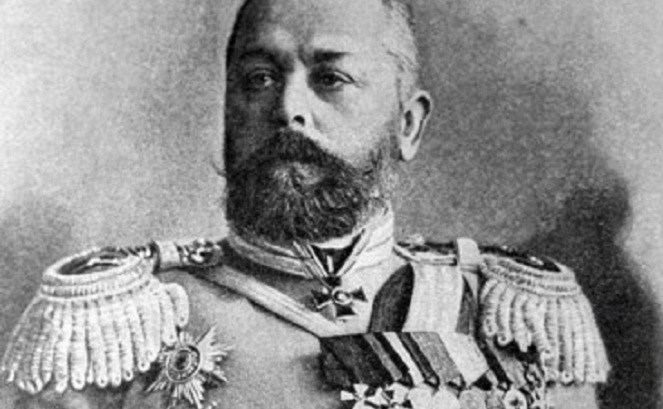Years of service ~1877–1914 Allegiance Russian Empire | Name Alexander Samsonov Rank General | |
 | ||
Born 14 November 1859
Andreevka, Kherson Governorate, Russian Empire (now in Ukraine) ( 1859-11-14 ) Battles/wars Boxer Rebellion
Russo-Japanese War
Battle of Mukden
World War I
Battle of Tannenberg Died August 30, 1914, Wielbark, Warmian-Masurian Voivodeship, Poland Battles and wars Boxer Rebellion, Russo-Japanese War, Battle of Mukden, World War I, Battle of Tannenberg Commands held Warsaw Military District, 2nd Army Similar People Paul von Rennenkampf, Maximilian von Prittwitz, Erich Ludendorff, Paul von Hindenburg, Aleksey Kuropatkin | ||
Service/branch Imperial Russian Army | ||
Alexander Samsonov | The Failure of Tannenberg (1859-1914)
Aleksandr Vassilievich Samsonov ( Russian: Алекса́ндр Васи́льевич Самсо́нов; 14 November [O.S. 2 November] 1859 – 30 August [O.S. 17 August] 1914) was a career officer in the cavalry of the Imperial Russian Army and a general during the Russo-Japanese War and World War I.
Contents

Biography

Samsonov was born in Kherson Governorate of the Russian Empire in what is now part of Ukraine. After graduation from the Vladimir of Kiev Cadet Corps and elite Nikolaev Cavalry School, he joined the Imperial Russian Army at age 18 as a cornet in the 12th Hussars Regiment.

Samsonov fought in the Russo-Turkish War, 1877–78. After this war he attended the Nikolaevsky Military Academy in St. Petersburg. On November 4, 1888 he was appointed senior aide to the staff of the 20th Infantry Division, and from July 10, 1885 to February 4, 1889 served as Senior Staff Adjutant to the Caucasus Grenadier Division. From March 11, 1890 through July 26, 1896 he worked at various assignments at the Warsaw Military District. He subsequently became commandant of the Elisavetgrad Cavalry School. During the Boxer Rebellion (1900), Samsonov commanded a cavalry unit. During the Russo-Japanese War (1904–1905), Samsonov commanded a cavalry brigade of the Ussuri Siberian Cossack Division. He was promoted to command all Russian cavalry forces in the First Siberian Army Corps following the Russian defeat at the Battle of Telissu. His forces subsequently protected the Russian flanks at the Battle of Liaoyang. Through these conflicts Samsonov gained a reputation as an energetic and resourceful leader, but some observers criticized his strategic abilities. After the Battle of Mukden in 1905, he accused General Paul von Rennenkampf of failing to assist him during the fighting. The ensuing quarrel made the two mutual lifetime enemies.

In 1906, Samsonov became Chief of staff of the Warsaw Military District, and in 1909 was Governor-General of Russian Turkestan and commander of the Turkestan Military District. He was also commander of the Semirechye Cossacks.

At the start of World War I, Samsonov received the command of the Second Army for the invasion of East Prussia. He advanced slowly into the south-western corner of East Prussia, intending to link up with General Rennenkampf's forces, which had started advancing from the north-east section. However, lack of communication between the two hindered co-ordination.

General (later Field Marshal) Paul von Hindenburg and General Erich Ludendorff, who arrived on the Eastern Front to replace General Maximilian von Prittwitz, engaged Samsonov's advancing forces. They made contact on August 22 and for six days the numerically superior Russians had some success. However, by August 29 the Germans, who were intercepting Russian wireless communications, had surrounded Samsonov's Second Army in the woods between Allenstein and Willenberg. The rout that followed was soon dubbed "the (Second) Battle of Tannenberg".
General Samsonov attempted to retreat, but with his army now trapped in a German encirclement, the German Eighth Army killed or captured most of his troops. Only 10,000 of the 150,000 Russian soldiers managed to escape the encirclement. Shocked by the disastrous outcome of the battle and unable to face reporting the scale of the disaster, for which he knew he would be held responsible to Tsar Nicholas II, Samsonov committed suicide on August 30, 1914 near Willenberg. His body was found by a German search party, a bullet wound in his head and a revolver in his hand. In 1916 his body was handed over by the Germans to his wife, through the intercession of the International Red Cross.
